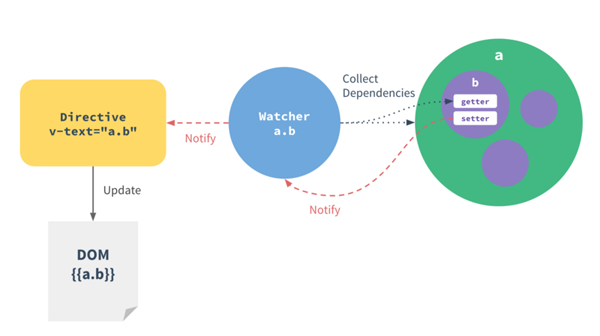这篇文章主要介绍“Vue.js的Hello World举例分析”,在日常操作中,相信很多人在Vue.js的Hello World举例分析问题上存在疑惑,小编查阅了各式资料,整理出简单好用的操作方法,希望对大家解答”Vue.js的Hello World举例分析”的疑惑有所帮助!接下来,请跟着小编一起来学习吧!
构造函数
文件路径:src/instance/vue.js
function Vue (options) { this._init(options) }初始化
这里只拿对例子理解最关键的步骤分析。文件路径:src/instance/internal/init.js
Vue.prototype._init = function (options) { ... // merge options. options = this.$options = mergeOptions( this.constructor.options, options, this ) ... // initialize data observation and scope inheritance. this._initState() ... // if `el` option is passed, start compilation. if (options.el) { this.$mount(options.el) } }merge options
mergeOptions()定义在src/util/options.js文件中,这里主要定义options中各种属性的合并(merge),例如:props, methods, computed, watch等。另外,这里还定义了每种属性merge的默认算法(strategy),这些strategy都可以配置的,参考Custom Option Merge Strategy
在本文的例子中,主要是data选项的merge,在merge之后,放到$options.data中,基本相当于下面这样:
vm.$options.data = function mergedInstanceDataFn () { var parentVal = undefined // 这里就是在我们定义的options中的data var childVal = function () { return { message: 'Hello World' } } // data function绑定vm实例后执行,执行结果: {message: 'Hello World'} var instanceData = childVal.call(vm) // 对象之间的merge,类似$.extend,结果肯定就是:{message: 'Hello World'} return mergeData(instanceData, parentVal) }init data
_initData()发生在_initState()中,主要做了两件事:
代理data中的属性
observe data
文件路径:src/instance/internal/state.js
Vue.prototype._initState = function () { this._initProps() this._initMeta() this._initMethods() this._initData() // 这里 this._initComputed() }属性代理(proxy)
把data的结果赋值给内部属性:文件路径:src/instance/internal/state.js
var dataFn = this.$options.data // 上面我们得到的mergedInstanceDataFn函数 var data = this._data = dataFn ? dataFn() : {}代理(proxy)data中的属性到_data,使得vm.message === vm._data.message:
文件路径:src/instance/internal/state.js
/** * Proxy a property, so that * vm.prop === vm._data.prop */ Vue.prototype._proxy = function (key) { if (!isReserved(key)) { var self = this Object.defineProperty(self, key, { configurable: true, enumerable: true, get: function proxyGetter () { return self._data[key] }, set: function proxySetter (val) { self._data[key] = val } }) } }observe
这里是我们的***个重点,observe过程。在_initData()***,调用了observe(data, this)对数据进行observe。在hello world例子里,observe()函数主要是针对{message: 'Hello World'}创建了Observer对象。
文件路径:src/observer/index.js
var ob = new Observer(value) // value = data = {message:'Hello World'}在observe()函数中还做了些能否observe的条件判断,这些条件有:
没有被observe过(observe过的对象都会被添加__ob__属性)
只能是plain object(toString.call(ob) === "[object Object]")或者数组
不能是Vue实例(obj._isVue !== true)
object是extensible的(Object.isExtensible(obj) === true)
Observer
官网的Reactivity in Depth上有这么句话:
When you pass a plain JavaScript object to a Vue instance as its data option, Vue.js will walk through all of its properties and convert them to getter/setters
The getter/setters are invisible to the user, but under the hood they enable Vue.js to perform dependency-tracking and change-notification when properties are accessed or modified
Observer就是干这个事情的,使data变成“发布者”,watcher是订阅者,订阅data的变化。

在例子中,创建observer的过程是:
new Observer({message: 'Hello World'})
实例化一个Dep对象,用来收集依赖
walk(Observer.prototype.walk())数据的每一个属性,这里只有message
将属性变成reactive的(Observer.protoype.convert())
convert()里调用了defineReactive(),给data的message属性添加reactiveGetter和reactiveSetter
文件路径:src/observer/index.js
export function defineReactive (obj, key, value) { ... Object.defineProperty(obj, key, { enumerable: true, configurable: true, get: function reactiveGetter () { ... if (Dep.target) { dep.depend() // 这里是收集依赖 ... } return value }, set: function reactiveSetter (newVal) { ... if (setter) { setter.call(obj, newVal) } else { val = newVal } ... dep.notify() // 这里是notify观察这个数据的依赖(watcher) } }) }关于依赖收集和notify,主要是Dep类
文件路径:src/observer/dep.js
export default function Dep () { this.id = uid++ this.subs = [] }这里的subs是保存着订阅者(即watcher)的数组,当被观察数据发生变化时,即被调用setter,那么dep.notify()就循环这里的订阅者,分别调用他们的update方法。
但是在getter收集依赖的代码里,并没有看到watcher被添加到subs中,什么时候添加进去的呢?这个问题在讲到Watcher的时候再回答。
mount node
按照生命周期图上,observe data和一些init之后,就是$mount了,最主要的就是_compile。
文件路径:src/instance/api/lifecycle.js
Vue.prototype.$mount = function (el) { ... this._compile(el) ... }_compile里分两步:compile和link
compile
compile过程是分析给定元素(el)或者模版(template),提取指令(directive)和创建对应离线的DOM元素(document fragment)。
文件路径:src/instance/internal/lifecycle.js
Vue.prototype._compile = function (el) { ... var rootLinker = compileRoot(el, options, contextOptions) ... var rootUnlinkFn = rootLinker(this, el, this._scope) ... var contentUnlinkFn = compile(el, options)(this, el) ... }例子中compile #mountNode元素,大致过程如下:
compileRoot:由于root node(<div id="mountNode"></div>)本身没有任何指令,所以这里compile不出什么东西
compileChildNode:mountNode的子node,即内容为"{{message}}"的TextNode
compileTextNode:
3.1 parseText:其实就是tokenization(标记化:从字符串中提取符号,语句等有意义的元素),得到的结果是tokens
3.2 processTextToken:从tokens中分析出指令类型,表达式和过滤器,并创建新的空的TextNode
3.3 创建fragment,将新的TextNode append进去
parseText的时候,通过正则表达式(/\{\{\{(.+?)\}\}\}|\{\{(.+?)\}\}/g)匹配字符串"{{message}}",得出的token包含这些信息:“这是个tag,而且是文本(text)而非HTML的tag,不是一次性的插值(one-time interpolation),tag的内容是"message"”。这里用来做匹配的正则表达式是会根据delimiters和unsafeDelimiters的配置动态生成的。
processTextToken之后,其实就得到了创建指令需要的所有信息:指令类型v-text,表达式"message",过滤器无,并且该指令负责跟进的DOM是新创建的TextNode。接下来就是实例化指令了。
link
每个compile函数之后都会返回一个link function(linkFn)。linkFn就是去实例化指令,将指令和新建的元素link在一起,然后将元素替换到DOM tree中去。每个linkFn函数都会返回一个unlink function(unlinkFn)。unlinkFn是在vm销毁的时候用的,这里不介绍。
实例化directive:new Directive(description, vm, el)
description是compile结果token中保存的信息,内容如下:
description = { name: 'text', // text指令 expression: 'message', filters: undefined, def: vTextDefinition }def属性上的是text指令的定义(definition),和Custome Directive一样,text指令也有bind和update方法,其定义如下:
文件路径:src/directives/public/text.js
export default { bind () { this.attr = this.el.nodeType === 3 ? 'data' : 'textContent' }, update (value) { this.el[this.attr] = _toString(value) } }new Directive()构造函数里面只是一些内部属性的赋值,真正的绑定过程还需要调用Directive.prototype._bind,它是在Vue实例方法_bindDir()中被调用的。
在_bind里面,会创建watcher,并***次通过watcher去获得表达式"message"的计算值,更新到之前新建的TextNode中去,完成在页面上渲染"Hello World"。
watcher
For every directive / data binding in the template, there will be a corresponding watcher object, which records any properties “touched” during its evaluation as dependencies. Later on when a dependency’s setter is called, it triggers the watcher to re-evaluate, and in turn causes its associated directive to perform DOM updates.
每个与数据绑定的directive都有一个watcher,帮它监听表达式的值,如果发生变化,则通知它update自己负责的DOM。一直说的dependency collection就在这里发生。
Directive.prototype._bind()里面,会new Watcher(expression, update),把表达式和directive的update方法传进去。
Watcher会去parseExpression:
文件路径:src/parsers/expression.js
export function parseExpression (exp, needSet) { exp = exp.trim() // try cache var hit = expressionCache.get(exp) if (hit) { if (needSet && !hit.set) { hit.set = compileSetter(hit.exp) } return hit } var res = { exp: exp } res.get = isSimplePath(exp) && exp.indexOf('[') < 0 // optimized super simple getter ? makeGetterFn('scope.' + exp) // dynamic getter : compileGetter(exp) if (needSet) { res.set = compileSetter(exp) } expressionCache.put(exp, res) return res }这里的expression是"message",单一变量,被认为是简单的数据访问路径(simplePath)。simplePath的值如何计算,怎么通过"message"字符串获得data.message的值呢?
获取字符串对应的变量的值,除了用eval,还可以用Function。上面的makeGetterFn('scope.' + exp)返回:
var getter = new Function('scope', 'return ' + body + ';') // new Function('scope', 'return scope.message;')Watch.prototype.get()获取表达式值的时候,
var scope = this.vm getter.call(scope, scope) // 即执行vm.message
由于initState时对数据进行了代理(proxy),这里的vm.message即为vm._data.message,即是data选项中定义的"Hello World"。
值拿到了,那什么时候将message设为依赖的呢?这就要结合前面observe data里说到的reactiveGetter了。
文件路径:src/watcher.js
Watcher.prototype.get = function () { this.beforeGet() // -> Dep.target = this var scope = this.scope || this.vm ... var value value = this.getter.call(scope, scope) ... this.afterGet() // -> Dep.target = null return value }watcher获取表达式的值分三步:
beforeGet:设置Dep.target = this
调用表达式的getter,读取(getter)vm.message的值,进入了message的reactiveGetter,由于Dep.target有值,因此执行了dep.depend()将target,即当前watcher,收入dep.subs数组里
afterGet:设置Dep.target = null
这里值得注意的是Dep.target,由于JS的单线程特性,同一时刻只能有一个watcher去get数据的值,所以target在全局下只需要有一个就可以了。
文件路径:src/observer/dep.js
// the current target watcher being evaluated. // this is globally unique because there could be only one // watcher being evaluated at any time. Dep.target = null
就这样,指令通过watcher,去touch了表达式中涉及到的数据,同时被该数据(reactive data)保存为其变化的订阅者(subscriber),数据变化时,通过dep.notify() -> watcher.update() -> directive.update() -> textDirective.update(),完成DOM的更新。
到此,关于“Vue.js的Hello World举例分析”的学习就结束了,希望能够解决大家的疑惑。理论与实践的搭配能更好的帮助大家学习,快去试试吧!若想继续学习更多相关知识,请继续关注亿速云网站,小编会继续努力为大家带来更多实用的文章!
免责声明:本站发布的内容(图片、视频和文字)以原创、转载和分享为主,文章观点不代表本网站立场,如果涉及侵权请联系站长邮箱:is@yisu.com进行举报,并提供相关证据,一经查实,将立刻删除涉嫌侵权内容。